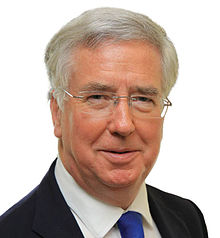Secretary of State for Defence
This article needs additional citations for verification. (September 2016) |
| United Kingdom Secretary of State for Defence | |
|---|---|
 Arms of Her Majesty's Government | |
 | |
since 15 July 2014 | |
| Ministry of Defence | |
| Style | The Right Honourable (Formal prefix) Defence Secretary |
| Member of | British Cabinet Privy Council National Security Council Defence Council Admiralty Board Army Board Air Force Board |
| Reports to | The Prime Minister |
| Seat | Westminster, London |
| Appointer | The British Monarch on advice of the Prime Minister |
| Term length | No fixed term |
| Formation | 1 April 1964 |
| First holder | Peter Thorneycroft |
| Website | www.gov.uk |
| This article is part of a series on |
| Politics of the United Kingdom |
|---|
 |
|
|
Her Majesty's Principal Secretary of State for Defence (Defence Secretary) is an official within Her Majesty's Government and head of the Ministry of Defence. The office is a British Cabinet level position.
The post was created in 1964 as successor to the posts of Minister for Coordination of Defence (1936–1940) and Minister of Defence (1940–1964). It replaced the positions of First Lord of the Admiralty, Secretary of State for War, and Secretary of State for Air, as the Admiralty, War Office and Air Ministry were merged into the Ministry of Defence (the Secretary of State for War had already ceased to be a cabinet position in 1946, with the creation of the cabinet level Minister of Defence).
Office holders
Minister for Co-ordination of Defence (1936–1940)
The position of Minister for Co-ordination of Defence was a British Cabinet-level position established in 1936 to oversee and co-ordinate the rearmament of Britain's defences.
The position was established by Prime Minister Baldwin in response to criticism that Britain's armed forces were understrength compared to those of Nazi Germany. This campaign had been led by Winston Churchill and many expected him to be appointed as the new minister, though nearly every other senior figure in the National Government was also speculated upon by politicians and commentators. Despite this, Baldwin's choice of the Attorney General Sir Thomas Inskip provoked widespread astonishment. A famous comment made in response to Inskip's appointment was "This is the most cynical appointment since Caligula made his horse a consul".[1] The appointment is now regarded as a sign of caution by Baldwin who did not wish to appoint someone like Churchill who would have been interpreted by foreign powers as a sign of the United Kingdom preparing for war, as well as a desire to avoid taking on board a controversial and radical minister.
In 1939 Inskip was succeeded by First Sea Lord Lord Chatfield. When the Second World War broke out, the new Prime Minister Neville Chamberlain formed a small War Cabinet and it was expected that Chatfield would serve as a spokesperson for the three service ministers, the Secretary of State for War, the First Lord of the Admiralty and the Secretary of State for Air; however, political considerations resulted in all three posts being included in the Cabinet, and Chatfield's role proved increasingly redundant. In April 1940 the position was formally wound up and the functions transferred to other Ministers.
Colour key (for political parties):
Conservative
none
| Name | Portrait | Term of office | Political party | Prime Minister | |||
|---|---|---|---|---|---|---|---|
| style="background-color: Template:Conservative Party (UK)/meta/color" | | Sir Thomas Inskip | 
|
13 March 1936 | 29 January 1939 | Conservative | style="background-color: Template:Conservative Party (UK)/meta/color" | | Stanley Baldwin (3rd National Min.) |
| height=30 style="background-color: Template:Conservative Party (UK)/meta/color" | | rowspan="2" style="background-color: Template:Conservative Party (UK)/meta/color" | | Neville Chamberlain (4th National Min.; War Coalition) | |||||
| style="background-color: Template:Independent (politician)/meta/color" | | The Lord Chatfield | 
|
29 January 1939 | 3 April 1940 | none | ||
Ministers of Defence (1940–1964)
The post of Minister of Defence was responsible for co-ordination of defence and security from its creation in 1940 until its abolition in 1964. The post was a Cabinet level post and generally ranked above the three service ministers, some of whom, however, continued to also serve in Cabinet.
On his appointment as Prime Minister in May 1940, Winston Churchill created for himself the new post of Minister of Defence. The post was created in response to previous criticism that there had been no clear single minister in charge of the prosecution of World War II. In 1946, the post became the only cabinet-level post representing the military, with the three service ministers – the Secretary of State for War, the First Lord of the Admiralty, and the Secretary of State for Air, now formally subordinated to the Minister of Defence.
Colour key (for political parties):
Conservative
Labour
Labour Co-op
none
Secretaries of State for Defence (1964–present)
The post of Secretary of State for Defence was created on 1 April 1964. The former Cabinet positions of First Lord of the Admiralty, Secretary of State for War and Secretary of State for Air (responsible for the Royal Navy, British Army and Royal Air Force respectively) were incorporated into it and the offices of the Admiralty, War Office and the Air Ministry were abolished and their functions transferred to an expanded Ministry of Defence.
Colour key (for political parties):
Conservative
Labour
References
- ^ This quote has been made on many occasions and the original source is unclear. The highly influential polemic Guilty Men (whose relevant chapter is entitled "Caligula's Horse") attributes it to a "great statesman" (page 74), whom some have surmised was Churchill. However Stewart, Graham Burying Caesar: Churchill, Chamberlain and the Battle for the Tory Party (London; Phoenix, 1999) (ISBN 0-7538-1060-3), page 487 attributes the originator of the quote to Churchill's non-politician friend Professor Frederick Lindemann.
































